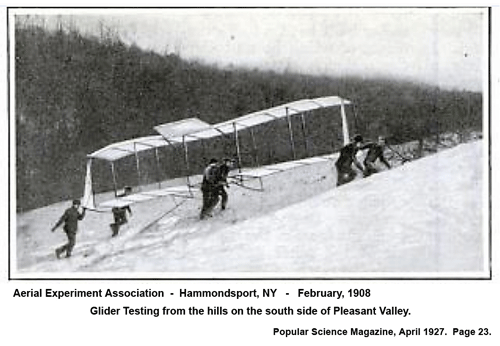Testing the AEA Glider - Winter 1908
In late December of 1907 the newly formed Aerial Experiment Association moved its centre of operations from the Alexander Graham Bell estate in Baddeck, Nova Scotia to Hammondsport, New York. The move was made to accommodate the construction of experimental "aerodromes" (aircraft) at the site of the Glenn H. Curtiss motorcycle plant in Hammondsport.
The construction and testing of a bi-plane glider was the first step by the AEA into building aircraft that were not based on tetrahedral kite construction. Previous work in Baddeck in the fall of 1907 had focused on testing the flight and man-lifting capability of the mammoth Cygnet kite created by Dr. Alexander Graham Bell.
In Hammondsport, a Chanute-type a glider was constructed to provide experience in constructing and flying an aerial device that would be similar to some of the emerging designs of other aeronautical pioneers pursuing the quest for controlled powered flight.

On January 13, 1908 the members of the AEA began flights with the glider on the hillsides just outside the village of Hammondsport.
Approximately fifty gliding flights were taken over two months. The initial flight was only a few feet long as the pilots struggled to find the balance point in the fledgling craft. By mid-March 1908 when they concluded work with the glider their flights were reaching the one hundred yard mark. The flights were mostly carried out by F.W. Casey Baldwin and Douglas McCurdy who stated that this experience served a very useful purpose by giving them a 'feel of the air' and how to balance a craft when it was airborn.
Prior to the glider flight test period, the members of the AEA had already determined that they would have to design a succession of machines, learning as they went, until they would be able to master all of the factors necessary to build, power, and manage the flight of an aerodrome. They decided that each member would be in charge of the design and construction of one machine. Early in January, as they finished work on the glider, they had already started the design of their initial aerodrome, the Red Wing. The aerodromes that followed were named: White Wing, June Bug, and Silver Dart.
The above photo is personal favourite from my kite library. To me it communicates a sense of enthusiasm, determination, and excitement as the AEA forged ahead with their quest "...to get into the air"!
_________________
Additional Reading:
- The Kites and Aerodromes of the Aerial Experiment Association.
- Members of the Aerial Experiment Association.
References:
Parkin, J. H. Bell and Baldwin: Their Development of Aerodromes and Hydrodromes at Baddeck, Nova Scotia. Toronto: University of Toronto Press. 1964 (555 pages)
C.R. Roseberry. Glenn Curtiss: Pioneer of Flight. Garden City, New York: Doubleday & Company, Inc. 1972. (514 pages) lIBRARY OF cONGRES nUMBER 70-171216
Charlotte Gray. Reluctant Genius: The Passionate Life and Inventive Mind of Dr. Alexander Graham Bell. Toronto: HarperCollins Publishers Ltd. 2006. (467 pages) ISBN-13: 978-0-00-200676-7
Frank Parker Stockbridge. Glenn Curtiss - Air Pilot No. 1. Popular Science Magazine, April 1927. Four pages beginning on Page 22. [Note: this is the second article in a four part series about aviation pioneer Glenn H. Curtiss.
References (1)
-
 Response: graphic design course in delhi
Response: graphic design course in delhi





Reader Comments